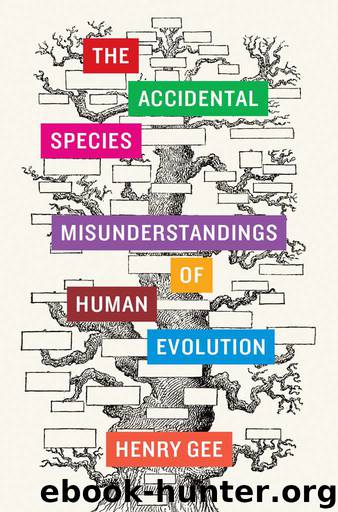The Accidental Species: Misunderstandings of Human Evolution by Henry Gee

Author:Henry Gee [Gee, Henry]
Language: eng
Format: epub, azw3
Publisher: University of Chicago Press
Published: 2013-10-15T00:00:00+00:00
7: The Way We Walk
It happened a long time ago, but the experience was so traumatic that I remember it as if it were yesterday—the moment when the outraged, elderly professor pinned me against a wall and harangued me for having rejected his paper on why human beings got up on their hind legs and walked. Human beings became bipeds, yelled the prof, to free the hands so that mothers could cuddle infants close to their chests. How could I have had the temerity, screamed the empurpled sage, to have rejected a paper that made so much sense?
One of the problems with human evolution, as opposed to, say, rocket science, is that everybody feels that their opinion has value irrespective of their prior knowledge (the outraged academic in the encounter above was a scientist, but not a biologist, still less an evolutionary biologist). It’s obvious to see why—we are all human beings, and we are all bipeds, so we think we know all about it, intuitively. What we think about bipedality “stands to reason.” Now, I’d be the last to disparage anyone who wanted to express an opinion, however cockeyed, but it is sometimes the case that the most perplexing problems are those that seem the simplest at first sight.
It is always a wonder to me that there is still much to be discovered about something so screamingly obvious as the way we humans walk. However, much about human walking remains to be understood. Why, for example, do we walk the way we do? Why, when moving faster than a certain speed, do we start to run? Why do we walk upright at all, when other animals get by perfectly well on all fours? These and other such questions are still being debated by scientists. I remember publishing a research paper showing that there was a perfectly feasible gait, somewhere between walking and running, which people never used.1 I enjoyed demonstrating the gait to my colleagues, as if it were something out of the famous Monty Python sketch about the Ministry of Silly Walks. We might not know the arcane secrets of the universe, but we are all perfectly familiar with walking and running, so how could there be a third, distinct gait, available all the time for our use, and we somehow missed it?
As anyone who has watched a cruising toddler will attest, simply the act of standing up on two feet requires a great degree of control, and scientists still have a great deal to learn about how this is achieved—and this is with modern human subjects who can be watched and their activities measured. And even after all this, robots that can walk with anything like the natural grace of a human have yet to be built. How much harder it is to learn about how bipedality evolved, still less why.2 The very fact of bipedality remains a taxing problem for those versed in fields as diverse as evolutionary biology, mechanical engineering, and robotics. It’s not the easy problem that people so often imagine.
Download
The Accidental Species: Misunderstandings of Human Evolution by Henry Gee.azw3
This site does not store any files on its server. We only index and link to content provided by other sites. Please contact the content providers to delete copyright contents if any and email us, we'll remove relevant links or contents immediately.
| Paleobiology | Paleozoology |
| Vertebrate |
Sapiens: A Brief History of Humankind by Yuval Noah Harari(13087)
The Tidewater Tales by John Barth(12040)
Do No Harm Stories of Life, Death and Brain Surgery by Henry Marsh(6345)
Mastermind: How to Think Like Sherlock Holmes by Maria Konnikova(6260)
The Thirst by Nesbo Jo(5802)
Why We Sleep: Unlocking the Power of Sleep and Dreams by Matthew Walker(5668)
Sapiens by Yuval Noah Harari(4560)
Life 3.0: Being Human in the Age of Artificial Intelligence by Tegmark Max(4525)
The Longevity Diet by Valter Longo(4458)
The Rules Do Not Apply by Ariel Levy(3920)
The Immortal Life of Henrietta Lacks by Rebecca Skloot(3835)
The Body: A Guide for Occupants by Bill Bryson(3829)
Why We Sleep by Matthew Walker(3784)
Animal Frequency by Melissa Alvarez(3764)
Yoga Anatomy by Kaminoff Leslie(3718)
Barron's AP Biology by Goldberg M.S. Deborah T(3640)
The Hacking of the American Mind by Robert H. Lustig(3590)
All Creatures Great and Small by James Herriot(3530)
Yoga Anatomy by Leslie Kaminoff & Amy Matthews(3411)
